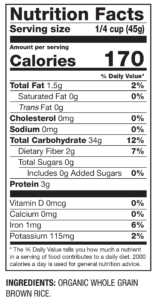Deciphering Food Labels

By Reed Mangels, PhD, RD
Have you ever noticed that the label on a package of rice or dried beans says that the serving size is ¼ cup? Who eats a ¼ cup of rice as a serving? I decided to dive into the US Food and Drug Administration (FDA) regulations about labels to find out the reasoning behind portion sizes on grains and beans.
According to the FDA’s website, “By law, serving sizes must be based on the amount of food people typically consume, rather than how much they should consume” (1). Information from national surveys are used to set label portion sizes for everything from bagels (a serving is 110 grams) to wine coolers (12 ounces) to ice cream (2/3 cup). Of course, if a package is a single-serving container, the serving size must be the entire bottle even if it contains more than the portion size set by the FDA (2). For example, if the FDA’s serving size for soda is 12 ounces and a bottle of soda has 20 ounces, the serving size for that product would be 1 bottle (20 ounces).
The FDA has designated 45 grams of dry product or 140 grams of prepared product as the serving size for grains such as rice and barley and 35 grams of dry product as the serving size for dried beans (3). Food companies are required to use a common household measurement like cups or tablespoons on the label and cannot just indicate how many grams there are in a serving (2). Thus, food producers must decide how to express 45 grams of dry grains or 35 grams of dry beans in terms of cups. Based on what I’ve observed, it’s common to use 1/4 cup of dry product as the portion size for dried beans and dry grains. Some companies do specify 1/4 cup (dry) but if they don’t, you’re safe to assume that if a quarter cup is listed as a serving, it’s likely to be the dry amount of the product. Some packages also include a statement along the lines of serving size: ¼ cup (makes ¾ cup prepared) but manufacturers are not required to do this.
If you’re trying to use the food label to figure out how many calories (or carbohydrates or other nutrients) are in a dry grain or dried bean that you’ve prepared, you have a few options.
- You could only prepare the amount that is identified on the package as the serving size – for example, 1/4 cup of dry brown rice – and see how much this makes when you cook it. Is that the usual amount that you eat or will you need to make more and then increase the nutrient content from the package accordingly?
- You could prepare the amount you usually make, perhaps 1-1/2 cups of dry brown rice, then determine the amount of cooked rice that this makes and back calculate to see how much cooked rice would result from 1/4 cup dry rice. Additional calculation could allow you to determine how many calories or nutrients are in the portion you eat.
- You could contact the manufacturer and politely request that they include a “prepared” amount on the label and inquire what that amount would be.
Ideally, in my opinion, FDA would make it easier for consumers who prepare foods from scratch and require food companies to use serving sizes that would be more meaningful than 1/4 cup of (dry) brown rice!
To read more about food labels see:
What’s Going On with Daily Values on Food Labels?
More About the Updates to the Daily Values on Food Labels
Puzzling Nutrition Information on Food Labels
References
1. FDA. Serving size updates on the new Nutrition Facts label. 2020. https://www.fda.gov/food/new-nutrition-facts-label/serving-size-updates-new-nutrition-facts-label
2. FDA. Food labeling: Serving sizes of foods that can reasonably be consumed at one eating occasion, reference amounts customarily consumed, serving size-related issues, dual-column labeling, and miscellaneous topics: Guidance for industry. 2019. https://www.fda.gov/media/133699/download
3. 21. CFR. 101.12. 2015. https://www.govinfo.gov/content/pkg/CFR-2015-title21-vol2/pdf/CFR-2015-title21-vol2-sec101-12.pdf
